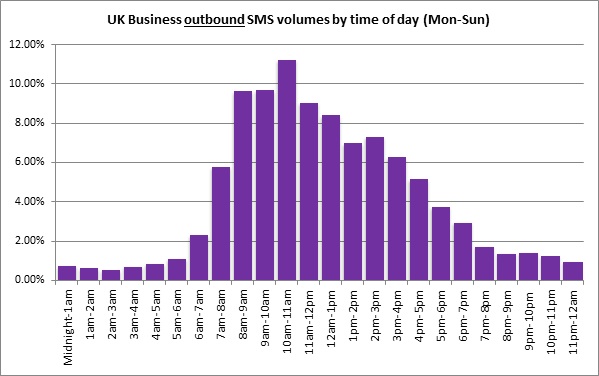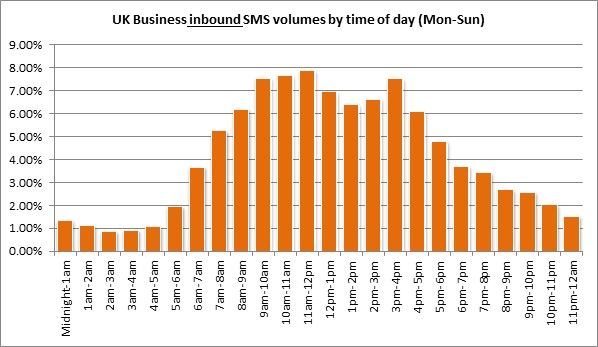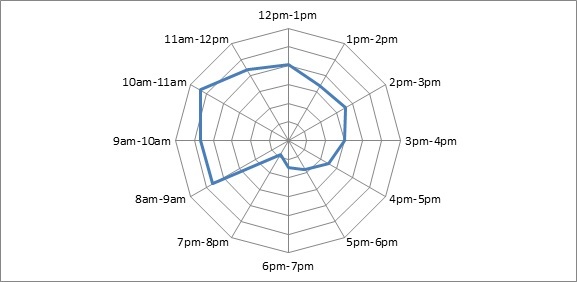There’s a theory about smartphone and tablet use that proposes that the best time to market to users is during the ‘coffee and couch’ times, during mid morning and evenings. It got us thinking: what are the most popular times for SMS communications? So we decided to run the numbers based on a sample set taken from traffic which runs over our network.
The key finding was that the ‘coffee’ peak time holds true. Looking at the UK market, the most popular time for British businesses to send a text is 10-11am, representing over 11.2% of traffic. They’re sent as part of a busy 9am-12pm slot that represents almost a third of all business SMS usage. But the evening peak didn’t happen at all. We believe that this is probably because businesses want to maximise the chances of the message being read and acted upon, so text earlier in the day.
The data reveals that night owls are less likely to receive a text from a company while they are awake, with 2-3am the least busy time for business SMS communications. The average time for a business to send a text is 12.13pm.
UK most popular time for businesses to text
The chart below demonstrates how the propensity for UK businesses to text customers and employees is clustered around the morning.
The international business SMS picture
We also looked at messaging patterns across 14.8 million messages sent by businesses in the UK, Ireland, France, Spain, Germany and Australia that regularly communicate via SMS.
Unlike in the UK, French business SMS volumes are more constant throughout the working day (8-9am and 5-6pm). It is the only country where businesses send a higher proportion of messages after 6pm, at 18%. This translated into a mean average time to send SMS of 1.58pm, compared to 12.13pm for the UK.
Australia, however, has the most concentrated period of sending messages in the early hours of the day, with 34% of all business text messages sent during just one hour (10.00-11.00am) each day and a mean average sending time of 11.20am. At the weekend, Australian businesses are more likely to send messages in the afternoon, with 28.3% of messages sent between 4-5pm, far higher than other markets analysed, which have an average of 5.46% of messages on average during this hour.
German and Irish business SMS use largely mirrors the UK’s, with a mean average most popular time of 12.16pm and 11.52am respectively, while the average time for Spanish businesses to send SMSs is much later, at 12.57pm.
Of course, It’s easy to jump to conclusions based on national stereotypes that suggest that Australians get up early, while Continental Europe is more engaged later in the day, but we believe the data highlights how SMS is used differently across international markets. For example, the inbound text data supports the notion that French businesses use SMS more for two-way communications, which explains why their outbound messages are spread across the day.
What next?
As Juniper Research has identified, volume wise, we’re still at the tip of the iceberg for business SMS use. It’s already used for a diverse range of applications such as marketing, delivery confirmation for retailers or clubs and societies updating members. In the future we expect to see businesses increasing communications tactically at other times of the day, reflecting the diversity of applying SMS to business communications. Another trend will be the increase of two-way communication as companies use SMS more interactively.
To get started on building your SMS Campaigns, read on for more information on Collecting Numbers for SMS Marketing.




